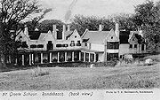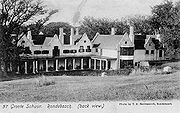
Groote Schuur
Encyclopedia

Cape Town
Cape Town is the second-most populous city in South Africa, and the provincial capital and primate city of the Western Cape. As the seat of the National Parliament, it is also the legislative capital of the country. It forms part of the City of Cape Town metropolitan municipality...
, South Africa
South Africa
The Republic of South Africa is a country in southern Africa. Located at the southern tip of Africa, it is divided into nine provinces, with of coastline on the Atlantic and Indian oceans...
.
Cecil Rhodes took out a lease on the house in 1891. He later bought it in 1893, and had it converted and refurbished by the architect Sir Herbert Baker
Herbert Baker
Sir Herbert Baker was a British architect.Baker was the dominant force in South African architecture for two decades, 1892–1912....
. The Cape Dutch
Cape Dutch architecture
-Introduction:Cape Dutch architecture is an architectural style found in the Western Cape of South Africa. The style was prominent in the early days of the Cape Colony, and the name derives from the fact that the initial settlers of the Cape were primarily Dutch...
building, located in Rondebosch
Rondebosch
Rondebosch is one of the Southern Suburbs of Cape Town, South Africa. It is primarily a residential suburb, with a medium-size shopping area, a small business district as well as the main campus of the University of Cape Town.-History:...
, on the slopes of Devil's Peak
Devil's Peak (Cape Town)
Devil's Peak is part of the mountainous backdrop to Cape Town. When looking at Table Mountain from the Victoria & Alfred Waterfront, or when looking at the standard picture postcard view of the mountain, the skyline is from left to right: the spire of Devil's Peak, the flat mesa of Table Mountain,...
, the outlying shoulder of Table Mountain, was originally part of the Dutch East India Company
Dutch East India Company
The Dutch East India Company was a chartered company established in 1602, when the States-General of the Netherlands granted it a 21-year monopoly to carry out colonial activities in Asia...
's granary constructed in the seventeenth century.
Little of the original house remained after a fire in 1866. The traditional thatched roof was replaced by sturdier Welsh slates. Rhodes gave no strict instructions as to what he wanted from Baker. Rhodes abhorred any mechanically made items (such as hinges for windows) in the house and set out to remove them and have them replaced with brass and bronze items that would be cast. Baker replaced the front of the house, added a long stoep in the back and constructed a new wing. The wing contained a billiard room and master bedroom above on the second floor that contained a large bay window
Bay window
A bay window is a window space projecting outward from the main walls of a building and forming a bay in a room, either square or polygonal in plan. The angles most commonly used on the inside corners of the bay are 90, 135 and 150 degrees. Bay windows are often associated with Victorian architecture...
overlooking Devil's Peak. He also added a grand hall with a massive fireplace.
Sir Herbert Baker also played a significant role in the furnishing of the house. After initially furnishing with modern furniture from London
London
London is the capital city of :England and the :United Kingdom, the largest metropolitan area in the United Kingdom, and the largest urban zone in the European Union by most measures. Located on the River Thames, London has been a major settlement for two millennia, its history going back to its...
, Rhodes, influenced by Baker, began a shift from the modern to more traditional Cape furniture. This would mark the beginning of Cecil Rhodes’ collection of colonial furnishings.
The gardens of the house were as Rhodes demanded 'masses of colour'. Surrounding the house was a mass of roses, hydrangeas, cannas, bougainvillea
Bougainvillea
Bougainvillea is a genus of flowering plants native to South America from Brazil west to Peru and south to southern Argentina . Different authors accept between four and 18 species in the genus...
s and fuchsias. Farther away from the house on the slopes of Devil's Peak, Rhodes kept antelopes, zebra, eland, wildebeest and ostriches.
Rhodes was always a generous host while at Groote Schuur. He used the residence as much as a business and political headquarters as a home. His life at the time was one of dinner parties and meetings on the stoep, where he would be joined by as many as fifty people.
From 1910 to 1984, it was the official Cape residence of the Prime Ministers of South Africa and continued as a presidential residence of P. W. Botha
Pieter Willem Botha
Pieter Willem Botha , commonly known as "P. W." and Die Groot Krokodil , was the prime minister of South Africa from 1978 to 1984 and the first executive state president from 1984 to 1989.First elected to Parliament in 1948, Botha was for eleven years head of the Afrikaner National Party and the...
and F. W. De Klerk
Frederik Willem de Klerk
Frederik Willem de Klerk , often known as F. W. de Klerk, is the former seventh and last State President of apartheid-era South Africa, serving from September 1989 to May 1994...
. However, P.W. Botha never resided there, opting rather to live in Westbrooke.
In May 1956, Time magazine reported, "a party was held at Groote Schuur for South Africa's Nationalist Prime Minister Johannes Strydom after he had won the parliamentary campaign to continue white supremacy in a land of 2.6 million whites and 10 million nonwhites. The party was given by some of the younger nationalists and their wives to honor him. They organized a caravan of 130 vehicles and slowly drove up to the Groote Schuur. After reaching the house, they began to sing old Boer war songs—the Volksliederen of the Transvaal and Orange Free State. A speech was given by Mrs. M.D.J. Koster, the only female member of the parliament, 'Every white woman and every white mother thanks you from the depth of her heart.' Strydom’s response to this was 'We must never be swerved from our goals...the struggle must continue.'"
The building was the site for the signing of the historic "Groote Schuur Minute" between Nelson Mandela
Nelson Mandela
Nelson Rolihlahla Mandela served as President of South Africa from 1994 to 1999, and was the first South African president to be elected in a fully representative democratic election. Before his presidency, Mandela was an anti-apartheid activist, and the leader of Umkhonto we Sizwe, the armed wing...
of the African National Congress
African National Congress
The African National Congress is South Africa's governing Africanist political party, supported by its tripartite alliance with the Congress of South African Trade Unions and the South African Communist Party , since the establishment of non-racial democracy in April 1994. It defines itself as a...
and F.W. De Klerk, the then President of South Africa, on 4 May 1990. The document was a commitment between the two parties towards the resolution of the existing climate of violence and intimidation as well as a commitment to stability and to a peaceful process of negotiations.
A working party was established to investigate the granting of temporary immunity to ANC
African National Congress
The African National Congress is South Africa's governing Africanist political party, supported by its tripartite alliance with the Congress of South African Trade Unions and the South African Communist Party , since the establishment of non-racial democracy in April 1994. It defines itself as a...
cadres, to advise on how to deal with the release of political prisoners and to make recommendations on the definition of political offenses.
Under Nelson Mandela
Nelson Mandela
Nelson Rolihlahla Mandela served as President of South Africa from 1994 to 1999, and was the first South African president to be elected in a fully representative democratic election. Before his presidency, Mandela was an anti-apartheid activist, and the leader of Umkhonto we Sizwe, the armed wing...
, the Genadendal building (formerly called Westbrooke) became the Cape Town residence of the South African President. Groote Schuur is now a museum and open to the public only by appointment.

